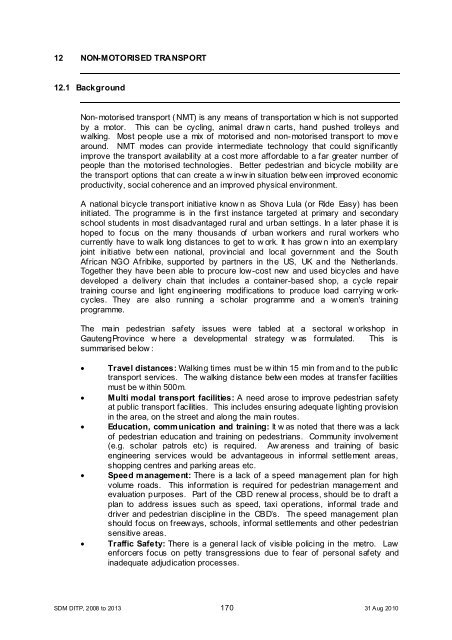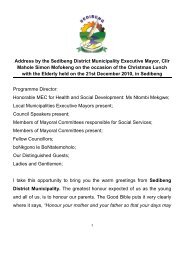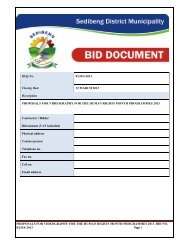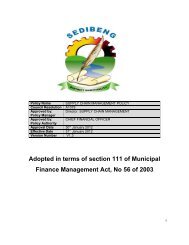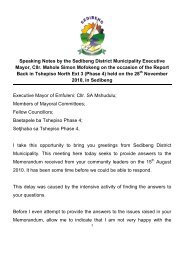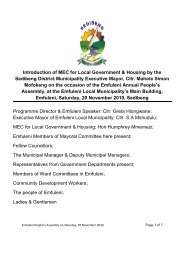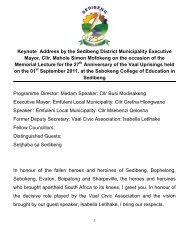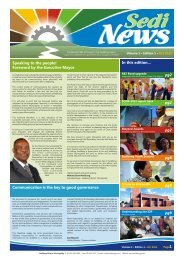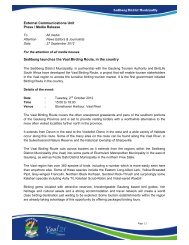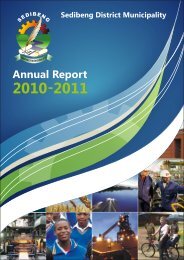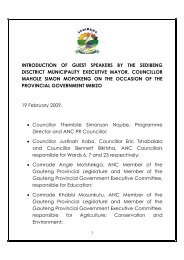Chapter 11 - Sedibeng District Municipality
Chapter 11 - Sedibeng District Municipality
Chapter 11 - Sedibeng District Municipality
You also want an ePaper? Increase the reach of your titles
YUMPU automatically turns print PDFs into web optimized ePapers that Google loves.
12 NON-MOTORISED TRANSPORT<br />
12.1 Background<br />
Non-motorised transport (NMT) is any means of transportation w hich is not supported<br />
by a motor. This can be cycling, animal draw n carts, hand pushed trolleys and<br />
walking. Most people use a mix of motorised and non-motorised transport to mov e<br />
around. NMT modes can provide intermediate technology that could significantly<br />
improve the transport availability at a cost more affordable to a far greater number of<br />
people than the motorised technologies. Better pedestrian and bicycle mobility are<br />
the transport options that can create a w in-w in situation betw een improved economic<br />
productivity, social coherence and an improved physical environment.<br />
A national bicycle transport initiative know n as Shova Lula (or Ride Easy) has been<br />
initiated. The programme is in the first instance targeted at primary and secondary<br />
school students in most disadvantaged rural and urban settings. In a later phase it is<br />
hoped to focus on the many thousands of urban workers and rural workers who<br />
currently have to walk long distances to get to w ork. It has grow n into an exemplary<br />
joint initiative betw een national, provincial and local government and the South<br />
African NGO Afribike, supported by partners in the US, UK and the Netherlands.<br />
Together they have been able to procure low-cost new and used bicycles and have<br />
developed a delivery chain that includes a container-based shop, a cycle repair<br />
training course and light engineering modifications to produce load carrying w orkcycles.<br />
They are also running a scholar programme and a w omen's training<br />
programme.<br />
The main pedestrian safety issues were tabled at a sectoral w orkshop in<br />
GautengProvince w here a developmental strategy w as formulated. This is<br />
summarised below :<br />
• Travel distances: Walking times must be w ithin 15 min from and to the public<br />
transport services. The walking distance betw een modes at transfer facilities<br />
must be w ithin 500m.<br />
• Multi modal transport facilities: A need arose to improve pedestrian safety<br />
at public transport facilities. This includes ensuring adequate lighting provision<br />
in the area, on the street and along the main routes.<br />
• Education, communication and training: It w as noted that there was a lack<br />
of pedestrian education and training on pedestrians. Community involvement<br />
(e.g. scholar patrols etc) is required. Aw areness and training of basic<br />
engineering services would be advantageous in informal settlement areas,<br />
shopping centres and parking areas etc.<br />
• Speed management: There is a lack of a speed management plan for high<br />
volume roads. This information is required for pedestrian management and<br />
evaluation purposes. Part of the CBD renew al process, should be to draft a<br />
plan to address issues such as speed, taxi operations, informal trade and<br />
driver and pedestrian discipline in the CBD’s. The speed management plan<br />
should focus on freeways, schools, informal settlements and other pedestrian<br />
sensitive areas.<br />
• Traffic Safety: There is a general lack of visible policing in the metro. Law<br />
enforcers focus on petty transgressions due to fear of personal safety and<br />
inadequate adjudication processes.<br />
SDM DITP, 2008 to 2013 170 31 Aug 2010


